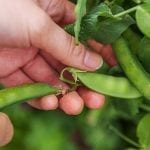
Discover How to Grow Onions and Savor Fresh Sweet Onions this Year!
There’s nothing like the sweet, savory flavor of fresh sweet onions. But, like tomatoes, the onions you buy at the grocery store were selected for their long storage lives and tolerance for shipping, not for their flavor.
Consequently, supermarket onions tend to be hot and spicy instead of sweet and subtle. While hot is good in some recipes, if you want that sweet, irresistible flavor that is just as scrumptious raw as it is cooked, your best options are to hope there’s a high-quality local farmer’s market where you can buy your vegetables, or to grow your own sweet onions.
Fear not! You don’t have to be a Master Gardener to grow delicious onions. Plus, there are lots of options as far as cost and work requirements go.
Read on to learn the essentials about 3 ways to grow onions, and savor the deliciousness this year!
How to Grow Onions from Sets
Onion sets are bulbs that go dormant at an early stage. They look like miniature onions (see photo above), and you will find them at your local gardening center, or even some supermarket produce departments or hardware stores that sell gardening supplies.
The big advantage to growing onions from sets is how easy it is; this is the easiest, least work-intensive of the three growing methods. The disadvantages are that this method costs quite a bit more than growing from seed, and you will be far more limited in your choice of onion varieties.
It’s pretty common for stores to simply label their onion sets by color (red, white, yellow) rather than by cultivar (Red Creole, Southport White Globe, Yellow Granex) so you won’t know exactly what you’re getting.
Choosing onion sets:
Buy onion sets at a local store. For best results, choose sets that have about the same diameter as a dime (roughly 1/2 inch). Larger sets tend to go to seed too quickly and result in smaller onions. Store the sets in a cool, dry place until you are ready to plant them.
Planting onion sets:
If you decide to grow onions from sets, the process is pretty simple. Just:
- Plant the sets 2 to 4 weeks before the last expected frost for your area (check the USDA’s website or your county’s gardening extension organization for this information).
- To plant the sets, make a shallow furrow that is just deep enough so that the pointed tops of the sets will be at the surface of the soil after you cover them. Space sets 4 to 6 inches apart, and cover them with soil. Pat the soil down lightly. If you like green onions, Organic Gardening Magazine suggests planting your sets closer together, and thinning them out at the green onion stage to leave the remaining onions 2 to 4 inches apart.
- To protect your onions, consider fastening a dig-proof covering such as chicken wire over your plantings. Many animals like the smell of the onions, and animals from gophers, to raccoons, and even dogs will dig up onion bulbs.
How to Grow from Transplanted Seedlings
Transplanting onion plants into your garden is the fastest way to grow onions, so this is the perfect method for gardening procrastinators. You can also grow your own plants from seed indoors (see instructions below) and transplant them into your garden.
The disadvantages of transplanting onions are that, if you buy plants, your choices of cultivars will be more limited and the plants will cost more than seeds or sets.
Choosing onion plants:
Gardening centers sell onion plants in flats. Choose green, healthy-looking plants. If you order onion plants online, be sure to choose a variety that is suited for the day length where you live (see the section on onion day length below).
Transplanting onions:
- Transplant them after the threat of hard freezes has passed. You can transplant a week or two before the last frost date, because onions tolerate light frost. Harden the plants before you transplant them by setting the flats outside for a few hours each day for about a week prior to transplanting. This will allow the plants to get accustomed to the outdoor environment.
- On the day of transplant, use clean scissors to trim the sprouts to about 4 to 6 inches in height.
- Dig a trench that is deep enough so that you can plant the seedlings slightly deeper than they are in the flats.
- Gently remove the plants from the flats, and gently shake the dirt free from the roots.
- Place the seedlings in the trench. Space them about 4 to 6 inches apart, or closer together if you want to thin some plants out as green onions later.
- Cover the roots with enough soil to be level with the rest of the ground. Then, gently pat the soil down.
- Water the seedlings.
Click here for a detailed, step-by-step guide for transplanting onions.
How to Grow Onions from Seed
If you’re looking for variety, growing onions from seed is the way to go. There are literally hundreds of onion cultivars available in the United States.
Gardening stores generally only sell a few varieties of onion seedlings or sets. Just be sure to choose onions that are well suited for the climate where you live.
Growing from seed also allows you to follow organic growing practices for your onions. Onion seeds are far less expensive than sets or transplants.
Like every growing method, growing onions from seed has its disadvantages. This is the most work-intensive method of the three.
This is because you will germinate the seedlings indoors before planting them in your garden. If you are planting fast-maturing onions such as scallions or bunching onions, you can sow the seeds directly into your garden.
Choosing onion seeds:
The main thing to look for is the onion day length. Onions “know” to start growing when the duration of springtime daylight hours reaches a certain length, and onion seed sellers classify their cultivars as short, intermediate, or long day length varieties.
In general, short day length onions grow best in the Southern U.S. (e.g. Florida, Southern California), intermediate at central U.S. latitudes (e.g. Iowa, Kentucky), and long day length onions are best for more northern latitudes (e.g. Ohio, New England, Pacific Northwest).
Check a day length map like the one in this article from Organic Gardening Magazine to find out which day length zone you live in, and only buy onion seeds that are the proper day length for your area.
Growing from seed:
For fast-maturing onions:
- Cornell University recommends sowing onion seeds when the soil temperature has reached 50 degrees Fahrenheit. Sow the seeds 1/4 inch deep. Space the seeds about 1/2 inch apart, and space rows 12 to 18 inches apart.
- As the onions grow, thin them to about 4 inches apart to get larger bulbs, or 2 inches apart to get smaller bulbs. For scallions, thin the plants to 1 inch apart.
For other types:
- Follow these instructions for growing vegetable seedlings indoors. Start seeds indoors in February or early March up north (8 to 10 weeks before the last frost date), or in the fall down south.
- When the sprouts grow tall, use scissors to trim them to about 4 to 6 inches. You can use the trimmings in salads or on baked potatoes.
- Follow the instructions above for transplanting onions.
Click here for detailed, step-by-step instructions for growing onions indoors.
Photos courtesy of (matt), Sprout Sprout, Oakley Originals.















